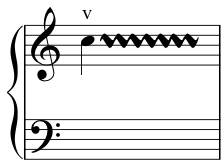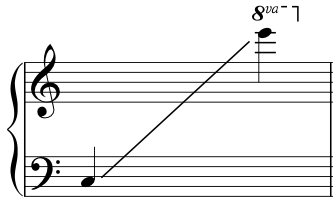Vibrato
Production
A vibrato of a single string can be produced by pressing the string between the tuning pin and the bridge pin. The right hand plays the string while the left hand presses it down or to the sides. Although it is also possible to press the string with the right hand, the left hand has much better access, since the strings are attached to the tuning pins on the left side of the harp's neck.
It is also possible to produce a vibrato on two strings at the same time, provided they are not more than two or three strings apart.
Sound
When the string is pressed a short vibrato of the string's pitch is heard. A vibrato is most audible if there are no tuning discs engaging the string, that is, when the pedals are in the flat position. When the pedals are in the natural and the sharp position the tuning discs cut the string below the bridge pin and therefore the vibrato effect, produced above the bridge pin, is less effective.
Notation
A vibrato is notated with a wavy line and the letter V above the note in question.

Vibrato.
Range
The vibrato effect is possible in the following range. Note that the lower limit can vary depending on the instrument:

Approximate vibrato range.
However, the vibrato effect is most effective in the high register. In the middle register the effect is possible but the strings have a very high tension and are difficult to push down. It is important to know that pressing the strings down, in all registers, is painful for the fingers, therefore the effect should be used sparingly.